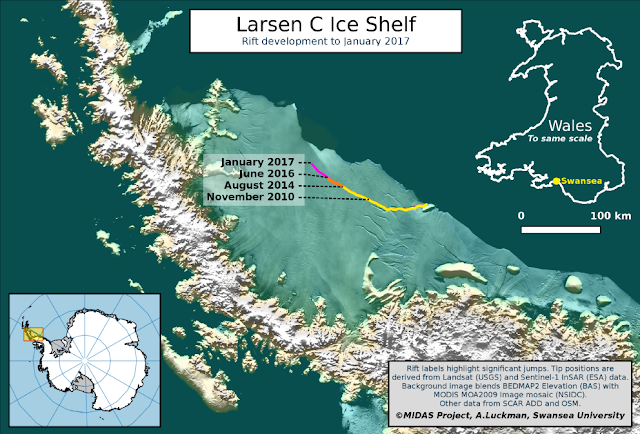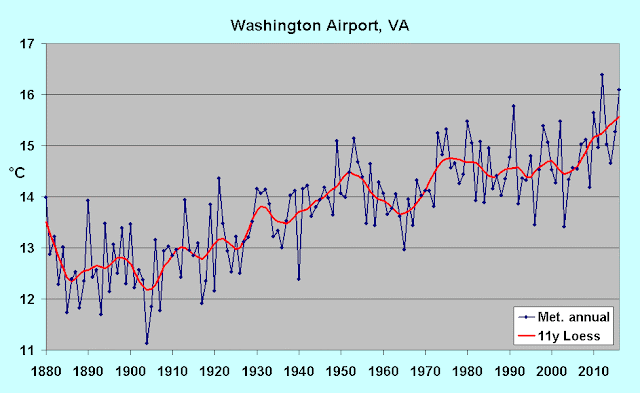The red circle marks Lo'ihi, a "sea-mount", an active undersea volcano which will eventually break the surface (in at least decades) as a new addition to the island chain. Mauna Loa is the big brown peak in the middle, and a dirt track leads eastward to the town of Hilo, where there's Hilo Airport, home to an atmospheric weather station. There they record temperature etc, and launch radiosondes to measure temperature, humidity and ozone to 30-35 km altitude:
| Steve about to release a radiosonde. Source: NOAA Earth System Research Laboratory. |
Check out the link to ESRL - well worth a read, and abstracts of papers on the role of ozone in climate included. The big "hill" in the background is dormant volcano Mauna Kea, at 4205 metres the highest point in the islands. Notice the grey volcanic soil - it took a great deal of work from the 1920s onwards to level the site for the airport, cutting away hard volcanic rock. Read about that here if you're interested - it's another good read. Happily, all the fixed surface instruments are on grass - I'd imagine that soil would get hotter than tarmac in the sun. OK - enough background stuff - cut to the chase, and the temperature record for Hilo Airport since 1950 - the reason for the start date will become clearer later.
 |
| Hilo Airport 1950-2016. Source: GISS |
I've circled 1966 in red - no warming since then until 2015-6. Global Warming delayed by a mere 50 years. Next temperature station to the NW is at Kahului Airport on Mau'i Island:
 |
| Kahului Airport, Mau'i. Source: GISS |
No warming at all since 1977 - I can't use a Loess filter because of the gap from 2005 to 2009, so I've plotted a linear trend 1977-2016. It's essentially flat. Skip an island or two with no current data, and we come to Honolulu, the capital city, and of course UHI - Urban Heat Island effect. Has that affected the temperature record? Almost certainly, however:
 |
| Honolulu Airport 1950-2016. Source: GISS |
I've circled 1984 - no warming since then. Notice there's no 2015-16 "spike" either, as seen at Hilo. I suspect something has happened there to cause it. I'm checking it out. Last but not least, further to the NW is Lihue, Kaua'i Island:
 |
| Lihue, Kaua'i, 1950-2016. Source: GISS |
No warming since 1970 (circled). So there we have it - an entire US state with a documented lack of "Global Warming" - it never was global, and there are many places all round the globe showing either a total lack of late-20C warming, or even cooling. If many Sceptics would stop their incessant and negative complaining about GHCN/GISS adjusted and "homogenised" temperature data, and actually use the extensive unadjusted database, there's an Aladdin's cave of debunking material to be extracted and put to good use.
Why did I start most of the charts at 1950? I found a real little gem from the EPA, "What Climate Change Means for Hawaii". It kicks off:
Hawaii’s climate is changing. In the last century, air temperatures have increased between one-half and one degree (F).Not a very good start - even though my charts above start at 1950, it's clear there's been a rise of around 1°C (almost 2°F) since then, and on full plots as much as 2°C (3.6°F) over the last 100 years. There's even a graphic to illustrate their error:
It's clear that Honolulu (top, brown) has increased from below 76°F to well over 77°F. There's no mention of the fact that even on this confused and confusing spaghetti-chart, it's clear that Honolulu hasn't warmed since the mid-1980s; that Hilo hasn't warmed since the mid-1960s; that Lihue hasn't warmed since about 1970, and that Kahului (grey, barely visible) hasn't warmed since the late 70s.
After some waffle about ocean warming (they say about 1°F) around Hawaii damaging coral reefs, there's this:
Greenhouse gases are also changing the world’s oceans and ice cover. Carbon dioxide reacts with water to form carbonic acid, so the oceans are becoming more acidic. The surface of the ocean has warmed about one degree during the last 80 years. Warming is causing snow to melt earlier in spring, and mountain glaciers are retreating. Even the great ice sheets on Greenland and Antarctica are shrinking. Thus the sea is rising at an increasing rate.Errr - CO2 reacts with sea-water, but it doesn't form carbonic acid (H2CO3). The author's using kindergarten science. Even highly-carbonated soft drinks have only very tiny amounts of carbonic acid in them. Most of the CO2 remains as CO2 in solution. Look it up, as I did, whereas this author, in common with many alarmists and their camp-followers, never have. Sea-water is strongly buffered, and the addition of CO2 reduces the alkalinity (negative pH) only a little. Saying that CO2 increases "acidity" is like saying that a reduction in your bank overdraft has "increased your bank balance".
Warmer air can certainly hasten snow-melt in spring, but it would take decades to centuries for slightly warmer air to have any effect on glaciers and ice-shelves. Air simply hasn't got the heat capacity and therefore content to do it over a few years, despite what glaciologists touchingly believe - they do have very vivid imaginations, and clearly know no relevant physics. A strong negative feedback is that melted surface ice (water!) evaporates, cooling the water. Latent heat of evaporation for water is an order of magnitude greater than latent heat of fusion for ice. Glaciologists also touchingly believe that surface melt-water can "permeate cracks in the ice" to reach the bottom of a glacier and "lubricate the base", so the glacier will advance faster. Ice-cold water can somehow permeate ice which is below freezing point to reach the base? Yeah, right - more "settled science".
Try heating your bath water using a fan-heater in the bathroom (don't try this at home!). In a well-insulated room, it would take weeks for the water to reach equilibrium with the hot air temperature. Topic for a future post here!
"Thus the sea is rising at an increasing rate." - well it's not. The "great ice sheet" on Greenland was shrinking, but that's slowed in recent years, not accelerated. The only part of the "great ice sheet" on Antarctica to display any melting was at the northern end of the Antarctic Peninsula - the very tip is even outside the Antarctic circle. Several papers published recently show that the "increasing temperatures" on the peninsula flattened off after 1990, and have been decreasing over the last 10-15 years. Topic for another post!
Satellite data shows global sea-level to be increasing at about 3 mm/year since 1993, and despite what some Sceptics would have you believe, in general, satellite data agrees fairly well with tide-gauge data. However, a big factor in the 3 mm/year figure was due to surface warming in the western Pacific, that's PDO and ENSO related, and both indices are reversing trend. Also, the satellites sample a lot of sea surface where there are no tide-gauges, and so it's likely that previous estimates of global rise have been under-stating the case for many decades. In general, tide-gauges show no late 20th.C acceleration correlating with atmospheric warming at all. Dozens of mainstream papers document that. I'll finish this post soon, I promise, just one last quote:
Since 1960, sea level has risen between two and eight inches relative to Hawaii’s shoreline. Sea level rise can make Hawaii’s existing coastal hazards—such as waves, hurricanes, tsunamis, and extreme tides—even worse. Additionally, rising sea level has accelerated coastal erosion, which has resulted in wetland migration and cliff collapse. Chronic erosion has affected more than 70 percent of Kauai and Maui’s beaches over the last century."Between two and eight inches" is a pretty wide estimate. Eight inches is the accepted estimate for global rise from 1880. I'll go into that in a post (in preparation) about sea-levels around the archipelago. I accept that many beaches have suffered "Chronic erosion", but I contend that the main reason is steeply-shelving beaches, which are prone to "Chronic erosion" whether sea-level is rising or not. That's well-documented. Have a look at this from the same EPA document:
Firstly, that pale golden sand is not Hawaiian sand. The islands are composed of very dark basaltic rocks - they're the tops of very large volcanoes. The natural colour is the same as the soil in the "balloon" picture above. The islands are famous for their "black beaches". Secondly, it's easy to see that the bottom shelves steeply down from the beach. This is the flank of a volcano, after all. The beaches aren't threatened by "climate change" but by natural erosion and longshore currents and rip-tides off the beaches - they're well documented too. Currents dangerous for swimmers erode beaches. Rising sea-levels must play a small part, and a gradually increasing part, but these exaggerated claims are just the usual "blame everything bad on climate change" meme. "What Climate Change Means for Hawaii" is just the usual alarmist nonsense, permeated by a few truths. Par for the course,










